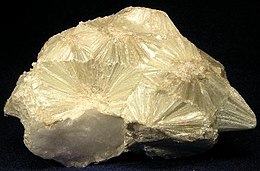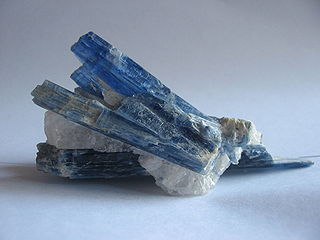
Kyanite is a typically blue aluminosilicate mineral, found in aluminium-rich metamorphic pegmatites and sedimentary rock. It is the high pressure polymorph of andalusite and sillimanite, and the presence of kyanite in metamorphic rocks generally indicates metamorphism deep in the Earth's crust. Kyanite is also known as disthene or cyanite.
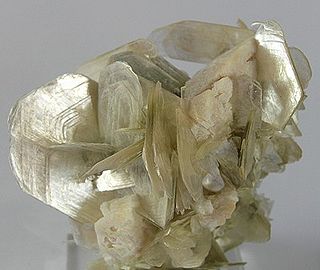
Muscovite (also known as common mica, isinglass, or potash mica) is a hydrated phyllosilicate mineral of aluminium and potassium with formula KAl2(AlSi3O10)(F,OH)2, or (KF)2(Al2O3)3(SiO2)6(H2O). It has a highly perfect basal cleavage yielding remarkably thin laminae (sheets) which are often highly elastic. Sheets of muscovite 5 meters × 3 meters (16.5 feet × 10 feet) have been found in Nellore, India.

Talc, or talcum, is a clay mineral composed of hydrated magnesium silicate, with the chemical formula Mg3Si4O10(OH)2. Talc in powdered form, often combined with corn starch, is used as baby powder. This mineral is used as a thickening agent and lubricant. It is an ingredient in ceramics, paints, and roofing material. It is a main ingredient in many cosmetics. It occurs as foliated to fibrous masses, and in an exceptionally rare crystal form. It has a perfect basal cleavage and an uneven flat fracture, and it is foliated with a two-dimensional platy form.

Petalite, also known as castorite, is a lithium aluminum phyllosilicate mineral LiAlSi4O10, crystallizing in the monoclinic system. Petalite occurs as colorless, pink, grey, yellow, yellow grey, to white tabular crystals and columnar masses. It occurs in lithium-bearing pegmatites with spodumene, lepidolite, and tourmaline. Petalite is an important ore of lithium, and is converted to spodumene and quartz by heating to ~500 °C and under 3 kbar of pressure in the presence of a dense hydrous alkali borosilicate fluid with a minor carbonate component. Petalite (and secondary spodumene formed from it) is lower in iron than primary spodumene, making it a more useful source of lithium in, e.g., the production of glass. The colorless varieties are often used as gemstones.
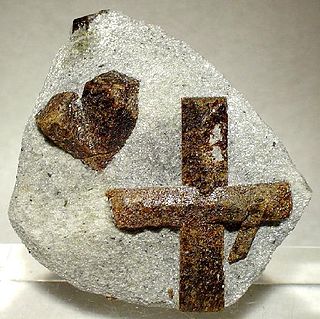
Staurolite is a reddish brown to black, mostly opaque, nesosilicate mineral with a white streak. It crystallizes in the monoclinic crystal system, has a Mohs hardness of 7 to 7.5 and the chemical formula: Fe2+2Al9O6(SiO4)4(O,OH)2. Magnesium, zinc and manganese substitute in the iron site and trivalent iron can substitute for aluminium.
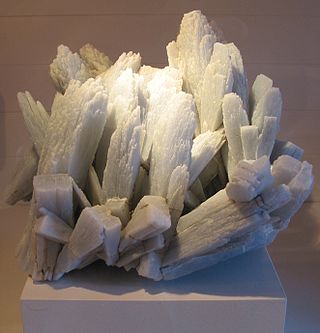
Anhydrite, or anhydrous calcium sulfate, is a mineral with the chemical formula CaSO4. It is in the orthorhombic crystal system, with three directions of perfect cleavage parallel to the three planes of symmetry. It is not isomorphous with the orthorhombic barium (baryte) and strontium (celestine) sulfates, as might be expected from the chemical formulas. Distinctly developed crystals are somewhat rare, the mineral usually presenting the form of cleavage masses. The Mohs hardness is 3.5, and the specific gravity is 2.9. The color is white, sometimes greyish, bluish, or purple. On the best developed of the three cleavages, the lustre is pearly; on other surfaces it is glassy. When exposed to water, anhydrite readily transforms to the more commonly occurring gypsum, (CaSO4·2H2O) by the absorption of water. This transformation is reversible, with gypsum or calcium sulfate hemihydrate forming anhydrite by heating to around 200 °C (400 °F) under normal atmospheric conditions. Anhydrite is commonly associated with calcite, halite, and sulfides such as galena, chalcopyrite, molybdenite, and pyrite in vein deposits.

Alunite is a hydroxylated aluminium potassium sulfate mineral, formula KAl3(SO4)2(OH)6. It was first observed in the 15th century at Tolfa, near Rome, where it was mined for the manufacture of alum. First called aluminilite by J.C. Delamétherie in 1797, this name was contracted by François Beudant three decades later to alunite.
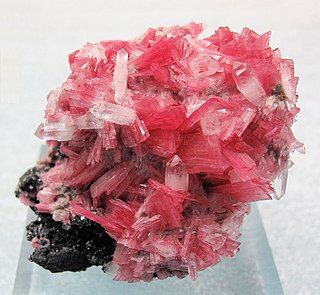
Rhodonite is a manganese inosilicate, with the formula (Mn, Fe, Mg, Ca)SiO3, and member of the pyroxenoid group of minerals, crystallizing in the triclinic system. It commonly occurs as cleavable to compact masses with a rose-red color (its name comes from Ancient Greek ῥόδον (rhódon) 'rose'), often tending to brown due to surface oxidation. The rose-red hue is caused by the manganese cation (Mn2+).
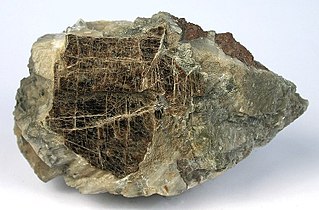
Clintonite is a calcium magnesium aluminium phyllosilicate mineral. It is a member of the margarite group of micas and the subgroup often referred to as the "brittle" micas. Clintonite has the chemical formula Ca(Mg,Al)
3(Al
3Si)O
10(OH)
2. Like other micas and chlorites, clintonite is monoclinic in crystal form and has a perfect basal cleavage parallel to the flat surface of the plates or scales. The Mohs hardness of clintonite is 6.5, and the specific gravity is 3.0 to 3.1. It occurs as variably colored, colorless, green, yellow, red, to reddish-brown masses and radial clusters.

The chlorites are the group of phyllosilicate minerals common in low-grade metamorphic rocks and in altered igneous rocks. Greenschist, formed by metamorphism of basalt or other low-silica volcanic rock, typically contains significant amounts of chlorite.
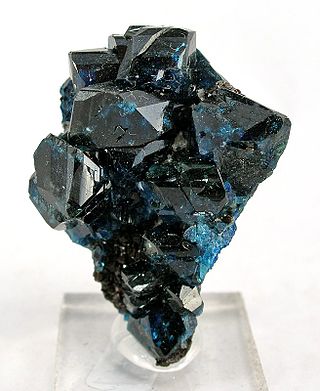
Lazulite ((Mg,Fe2+)Al2(PO4)2(OH)2) is a blue, phosphate mineral containing magnesium, iron, and aluminium phosphate. Lazulite forms one endmember of a solid solution series with the darker iron rich scorzalite.

Margarite is a calcium rich member of the mica group of the phyllosilicates with formula: CaAl2(Al2Si2)O10(OH)2. It forms white to pinkish or yellowish gray masses or thin laminae. It crystallizes in the monoclinic crystal system. It typically has a specific gravity of around 3 and a Mohs hardness of 4. It is translucent with perfect 010 cleavage and exhibits crystal twinning.
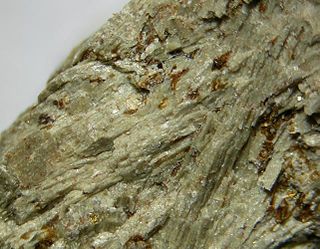
Aliettite is a complex phyllosilicate mineral of the smectite group with a formula of (Ca0.2Mg6(Si,Al)8O20(OH)4·4H2O) or [Mg3Si4O10(OH)2](Ca0.5,Na)0.33(Al,Mg,Fe2+)2−3(Si,Al)4O10(OH)2·n(H2O).

Svanbergite is a colorless, yellow or reddish mineral with the chemical formula SrAl3(PO4)(SO4)(OH)6. It has rhombohedral crystals.
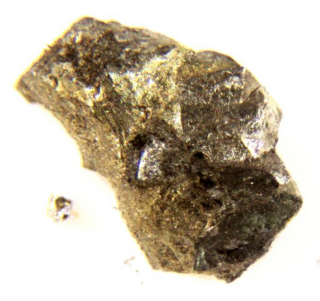
Vulcanite is a rare copper telluride mineral. The mineral has a metallic luster, and has a green or bronze-yellow tint. It has a hardness between 1 and 2 on the Mohs scale. Its crystal structure is orthorhombic.

Berlinite (aluminium phosphate, chemical formula AlPO4 or Al(PO4)) is a rare high-temperature hydrothermal or metasomatic phosphate mineral. It has the same crystal structure as quartz with a low temperature polytype isostructural with α–quartz and a high temperature polytype isostructural with β–quartz. Berlinite can vary from colorless to greyish or pale pink and has translucent crystals.
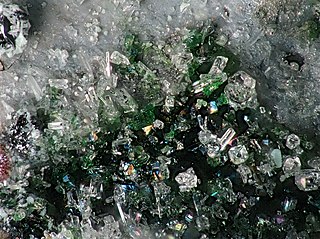
Bunsenite is the naturally occurring form of nickel(II) oxide, NiO. It occurs as rare dark green crystal coatings. It crystallizes in the cubic crystal system and occurs as well formed cubic, octahedral and dodecahedral crystals. It is a member of the periclase group.
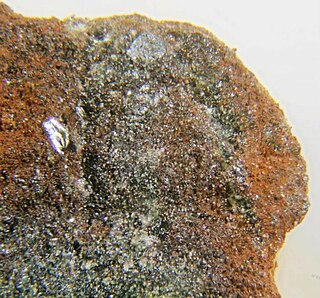
Minnesotaite is an iron silicate mineral with formula: (Fe2+,Mg)3Si4O10(OH)2. It crystallizes in the triclinic crystal system and occurs as fine needles and platelets with other silicates. It is isostructural with the pyrophyllite-talc mineral group.

Antigorite is a lamellated, monoclinic mineral in the phyllosilicate serpentine subgroup with the ideal chemical formula of (Mg,Fe2+)3Si2O5(OH)4. It is the high-pressure polymorph of serpentine and is commonly found in metamorphosed serpentinites. Antigorite, and its serpentine polymorphs, play an important role in subduction zone dynamics due to their relative weakness and high weight percent of water (up to 13 weight % H2O). It is named after its type locality, the Geisspfad serpentinite, Valle Antigorio in the border region of Italy/Switzerland and is commonly used as a gemstone in jewelry and carvings.
Falcondoite, a member of the sepiolite group, was first discovered in the Dominican Republic, near the town of Bonao. The mineral was found in a deposit mined by Falconbridge Dominica, and so was named "falcondoite" after the company. Falcondoite is frequently associated with sepiolite, garnierite, talc, and serpentine, and is commonly nickel-bearing. While the chemical formula for falcondoite can vary, the mineral must contain more nickel than magnesium to be considered its own species. The ideal chemical formula for falcondoite is (Ni,Mg)4Si6O15(OH)2·6H2O.
.
